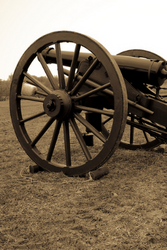Civil War Artillery at Gettysburg
17th Jul 2020

Artillery in the 1800''s fought side by side with infantry units because the range of the big guns limited them to visible targets. Like the infantry weapons, Civil War-era cannon were muzzle loaders and required a crew of eight men to aim, load, and fire the weapon. Maintaining the large guns was an important job and discipline in the artillery was very strict due to the value of the weapon. One artillery unit was referred to as a battery. Composed of six cannon and just over one hundred men, the battery was commanded by a captain. Many batteries were companies of an artillery regiment. Battery A, 4th US Artillery or Battery B, 1st New York Light Artillery are examples of this. Some northern states raised "independent" batteries, which were not attached to an artillery regiment. New York supplied fifteen independent batteries including Captain Andrew Cowan''s 1st New York Battery and Captain Patrick Hart''s 15th New York Battery, both of which fought at Gettysburg. Confederate batteries were, for the most part, labeled by the nicknames of where they were raised or by the name of the battery commander. The "King William Artillery", commanded by Captain W.P. Carter, was typical of a Virginia organization. In the same battalion were the "Jeff Davis Artillery" from Alabama, and the "Morris Artillery" and "Orange Artillery" from Virginia.
There were several different types of field cannon developed prior to and during the war with many different nomenclatures. Four distinctive models were used in the battlefield at Gettysburg:

12-pounder bronze gun, Model of 1857

2.9-inch (10-pounder) Parrott Rifle
Confederate copies of the Parrott Rifle were produced by the Noble Brothers Foundry and the Macon Arsenal in Georgia. Parrott Rifles in 10 and 20-pounder sizes were sprinkled throughout some southern batteries.

3-inch Wrought Iron Gun
This sleek weapon was also called the 3-inch Ordnance Rifle and was designed by John Griffen, superintendent of the Safe Harbor Iron Works in Pennsylvania. The initial design was built by the Phoenix Iron Company of Phoenixville, Pennsylvania which manufactured most of the 3-inch Rifles used in the Union Armies. This iron gun was similar in length to the Parrott Rifle, fired an elongated shell, and was deadly accurate up to a mile. Much lighter than the Napoleon, the gun weighed an average of 800 pounds and could be easily transported and manhandled by its crew. Only a limited number of copies of the Ordnance Rifle were produced at Confederate arsenals.
Model 1841 12-pounder Howitzers
A pre-war bronze gun dating back to the 1840''s, a number of howitzers were still in use by the Army of Northern Virginia during the Gettysburg Campaign. The barrels of these guns are several inches shorter than other artillery pieces giving them a stubby appearance. These powerful guns packed a whallop at close range but were not desirable for long range work. Larger 24-pounder field howitzers were also produced and though some appeared at Gettysburg, their use was mostly limited to forts and stationary defenses by this time of the war.
There were a number of other unusual guns in use by both sides during the campaign. Two of these are:
3.8-inch James Rifle
2.75-inch Whitworth Rifle
Civil War cannons were mounted on carriages made of oak with iron fittings. There were several different sizes of carriages to accommodate each type of cannon. Carriages at Gettysburg National Park today are made of cast iron and are made to replicate the look of the old carriages. These were made in a Gettysburg foundry by Calvin Hamilton, a Civil War veteran, between 1895 and 1910.
There were many types and styles of artillery rounds manufactured during the Civil War. Smoothbore guns such as 12-pounder Napoleons and howitzers fired round cannon balls. Elongated or conical-shaped shells were used in rifled cannon. The four basic types of artillery round included SOLID SHOT for use against large infantry formations or opposing artillery, and SHELL which was a hollow iron shell filled with black powder and ignited by a length of paper fuze or a percussion fuze. CASE was similar to a shell- hollow inside and filled with black powder with the addition of iron balls. The fourth type of artillery round was CANISTER, a tin can filled with iron balls and used against infantry and cavalry formations at close range. When fired, canister turned the cannon into a large shotgun.
An artillery shell was affixed to a wooden base and a cloth bag filled with one to two pounds of black powder. The shell was placed into the muzzle of the cannon and rammed into the breech. The bag was pierced with a sharp wire through the vent at the breech and ignited by a friction primer- a copper tube filled with ignition powder & fulminate of mercury. The primer was attached to a lanyard that when pulled, drew a serrated wire through the primer igniting the charge. An efficient gun crew could load and fire up to three rounds per minute. This deadly efficiency was never more evident than on July 3rd during Pickett''s Charge. A variety of ammunition was used against the Confederate infantry formations. One solid shot plowed into Company I, 53rd Virginia Infantry knocking out 12 men. As the Confederates swarmed up to the Union positions, Union gunners desperately loaded and fired double charges of cannister into the gray ranks with devastating results. It is no wonder that infantrymen had such high respect, and loathing, for the big guns.
United States Department of the Interior


 Gift Cards
Gift Cards